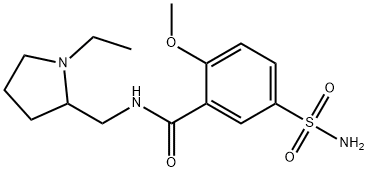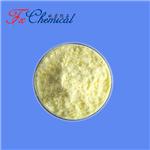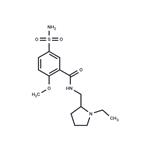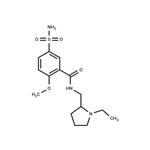
Sulpiride
- Product NameSulpiride
- CAS15676-16-1
- CBNumberCB4141314
- MFC15H23N3O4S
- MW341.43
- EINECS239-753-7
- MDL NumberMFCD00055061
- MOL File15676-16-1.mol
- MSDS FileSDS
Chemical Properties
| Melting point | 178-180° |
| alpha | D25 -66.8° (c = 0.5 in DMF) |
| Density | 1.2375 (rough estimate) |
| refractive index | 1.6320 (estimate) |
| storage temp. | 2-8°C |
| solubility | 45% (w/v) aq 2-hydroxypropyl-β-cyclodextrin: 8.0 mg/mL |
| form | powder |
| pka | pKa1 9.00, pKa2 10.19(at 25℃) |
| color | yellow |
| Water Solubility | <0.21g/L(25 ºC) |
| λmax | 232nm(EtOH)(lit.) |
| Merck | 14,8989 |
| InChIKey | BGRJTUBHPOOWDU-UHFFFAOYSA-N |
| LogP | 0.57 |
| CAS DataBase Reference | 15676-16-1(CAS DataBase Reference) |
| EWG's Food Scores | 1 |
| FDA UNII | 7MNE9M8287 |
| ATC code | N05AL01 |
Safety
| Symbol(GHS) |

|
| Signal word | Warning |
| Hazard statements | H361 |
| Precautionary statements | P280 |
| Hazard Codes | Xi |
| Risk Statements | 36/37/38 |
| Safety Statements | 26-36 |
| WGK Germany | 2 |
| RTECS | BZ3400000 |
| HS Code | 2933.99.6100 |
| Toxicity | LD50 in mice (mg/kg): 170 i.p.; 2250 orally (Dostert) |



